
Do you need help attracting traffic to your website, or are you just curious how to get your business website to the top of Google’s search results? The solution is to adhere to Google ranking factors.
About 200 Google ranking factors can affect your website’s ranking in search results. The good part is that you just need to follow some of them to get impressive results from your website.
In this blog, we have discussed the most important Google ranking factors that you need to know to improve your SEO rankings and increase your returns on investment. What we provide is not just ranking factors but your website’s success mantra. So, without wasting your time, let’s get down to business.
You probably already know that Google is the world's leading search engine in popularity and usage, with its desktop and mobile versions. Millions of searches are made daily, but remaining at Google’s top search results remains the concern of every seo specialist, website, or business owner.
While searching on Google, you must have noticed that you will find some numbers as you scroll down to the end of the page. Generally, they are serial numbers from 1 to 10 or even more.
*Screenshot
Have you ever clicked them?
These are additional result pages that answer the same query you just made.
But what is the difference between the first-page search results and search results that are on 2… 10….?
Think of it this way: In a competitive exam, only the top rankers are considered for further rounds or services, not the bottom candidates. This is because the top rankers are deemed capable of handling significant responsibilities.
Specific criteria or factors are decided during such exams, which candidates, when qualified, are deemed eligible.
This example may be crude, but it does complete justice while explaining the core difference between the first-page search results and the last-page search results. How?-
Google is a trusted brand on which millions of people rely. To live up to its reputation and reliability, it has set specific guidelines to which you must adhere. Only then will your website, business, or provided information be considered to appear at the top of Google’s Search Result Pages.
“Ranking factors are the significant guidelines based on which Google decides which search results to display and at what order in its search results for a particular query.”
Simply put, the art and science of remaining at the top of search page results are Google ranking factors.
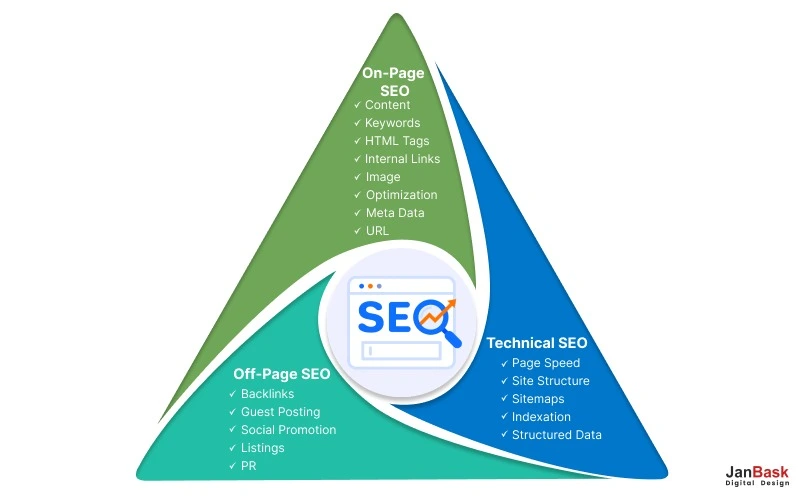
Did you know more than 200 Google ranking factors that decide which sequence a website should appear on result pages? These different categories ensure that a website displayed at the top of search results deserves to hold that position.
As the name suggests, On-page comprises all the elements visible to a user on a website. When these On-page elements, such as the website's content, keywords used, meta tags, images, and some others, are optimized as per Google’s guidelines, they enhance search engine result rankings.
When optimization work is performed on elements not visible on a website and perpetrated in the backend, these are identified as off-page ranking factors. These ranking factors influence a website's authority and relevance through backlinks from other sites, social media presence, and brand mentions on the internet.
These represent the technical aspects of your website, such as how easy it is to be crawled, how soon it loads, how safe it is to use your website while sharing sensitive data, and so on, which we will discuss in depth later in the blog.
Making your business website or any website successful depends on how well you understand the ranking factors and how effectively you execute them in your strategy.
To avoid swindling by free-lunchers, Google regularly updates its ranking factors, making them diverse and reliable.
It is often less challenging to reach the top of Google’s search results than to remain there consistently. Keep yourselves updated with the latest top Google ranking factors and apply them to your website for a lasting position in top search results.
To reach the top search result pages, you must coherence to these 8 core Google ranking factors.
Boost Your Rankings Now: Discover the Google Ranking Factors!

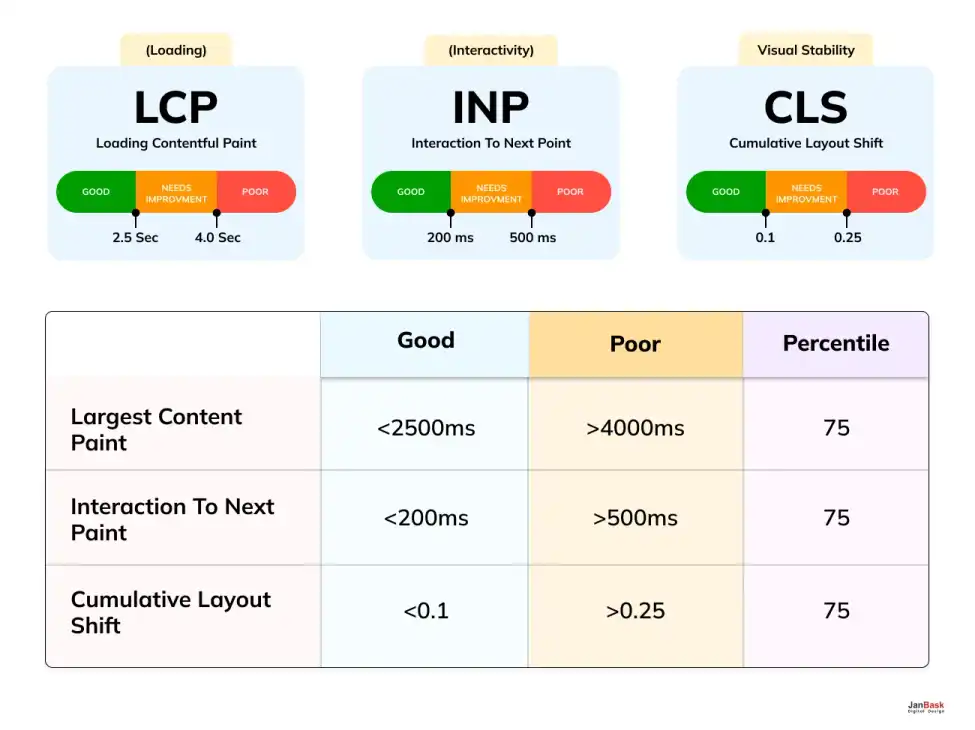
Core web vitals, or CWVs, are as vital as they sound. They are a set of metrics that Google uses to identify how well any website responds to human interactions. CWV algorithms measure:
LCP measures the render time for your website's most prominent elements, such as images, videos, or text content, to load. Google recommends that a website have an LCP score of 2.5 seconds or less to pass the ranking parameters.
This is a Core Web Vital metric that measures the time it takes for a website to respond to an interaction. Simply put, it measures the latency of an action on the website, such as scrolling or clicking, and the time it takes to respond. A website has good INP if it takes 200 milliseconds or less to respond to any interaction.
*video
CLS measures the visual stability of your website, meaning that if you try to click on a website element, it suddenly moves, making you click on the wrong section or links. This significant ranking factor is taken very seriously when Google allots search results positions. If your website's CLS score is under 0.1, it will be considered to provide a good user experience.
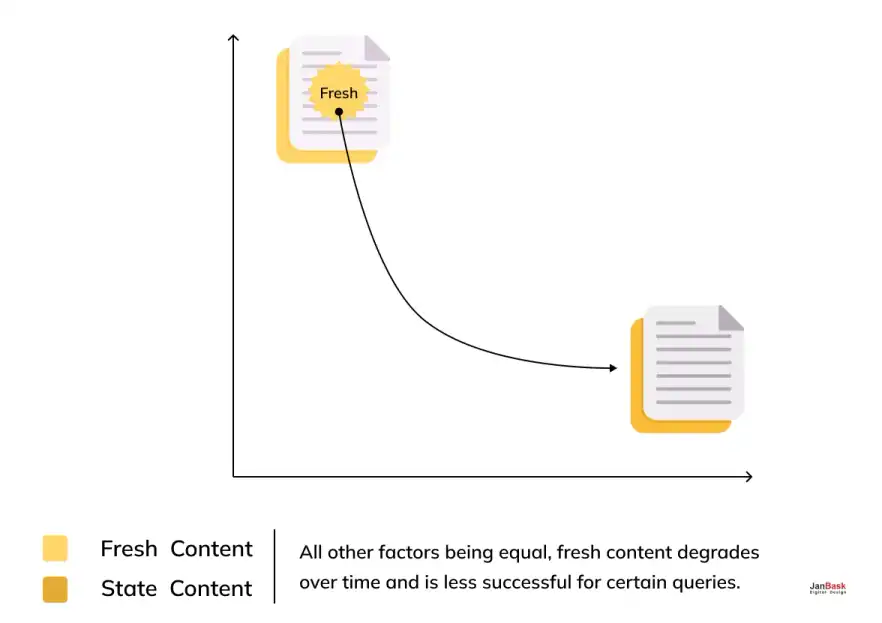
"Content is king" is more than Bill Gates's essay topic. High-quality content is not only responsible for your website's SEO ranking but is an equally important Google ranking factor. The primary purpose of any query made on Google is to get accurate answers for them.
Google's automated ranking system has evolved so much from the past that it now provides answers closest to the query's intent. It scans the whole internet to provide relevant information as soon as a query is searched for.
Google has always proclaimed that websites publishing fresh, genuine, and people-first content are destined to rank higher in their search results.
In our years of experience in digital marketing and providing high-quality content for clients, we have noticed that writers sometimes present similar content. Google has a strict policy condemning the use of duplicate content or content patterns that resemble information from other sites. If a website has paraphrased content, it is deemed to receive penalties, or worse, the website can even get kicked from Google's index entirely.
Increase your SEO rankings by ensuring your content has the following:
We have compiled some solid and practical strategies for ranking your content if it adheres to them. These strategies have been collected from Google's past indexing data and internal data leaks.
Google introduced E-A-T in August 2018 and added an extra 'E' later in 2022. It was a significant update towards content that included Your Money Your Life (YMYL) information, which concerned the well-being and safety of its searchers.
Google initiated this system of analyzing a website's content when it realized that people search for all sorts of queries, including those involving real-world consequences.
Imagine someone is using Google to find out about an ongoing epidemic, is stranded in a life-death situation, or is about to make a significant financial decision. The queries related to sensitive information should not just be of high quality but should also come from a genuine and trustworthy resource. And this is what EEAT stands for:
These measures ensure that the information displayed to the searchers is from relevant sources and contains accurate and expert information.
You must understand that E-E-A-T is not a direct Google ranking factor; it is more of a Search quality rater guideline that human raters use to evaluate the displayed search results. However, websites complying with these guidelines will surely rank higher in search results.
E-E-A-T is not limited to websites that deal with YMYL topics; it is super beneficial for any website. It tells the algorithm that the information provided on it is of the highest standards and comes from genuine, first-hand resources. Understand them and follow them in your content strategy:
Experience:
Whenever you write content for your landing pages, blogs, articles, etc., let your viewers know it comes from an experienced source. Let them know that the website's content comes from well-experienced people familiar with the discussed subject matter.
You can use the help of author bylines, where you can show when the content was last updated and by whom. Vides content such as 'after' or 'before' shoots can help a lot, and you can also use literal past experiences you have in the content being discussed.
This tells the audience and Google's algorithm that the content is the latest and comes from an experienced source.
Expertise:
Your content structure should reflect the expertise behind the produced content. Well-explained and segmented content that covers the intricacies of the matter automatically becomes a reader's magnet. To further demonstrate expertise, you can include an author's section in your blogs and articles and interlink sources of gained information on your website.
Authoritativeness:
Your website's authoritativeness score shows how well you work to establish your sovereignty as a business or a brand. To increase authoritativeness, make it a practice to publish regular, high-quality content to your audience. Moreover, try getting as many mentions as possible from other trusted websites in your niche.
Trustworthiness:
Trust is the major bonding factor between any business and its customers. Be transparent about the information provided. Provide proper channels for your customers to manage their doubts or disputes. This will make Google and your audience trust you as a business.
Google really likes it when you present your audience with fresh and updated content. Do include mentions such as when the content was written or last updated and by whom.
Change is inevitable, but presenting your audience with the latest news and trends improves your SEO ranking. When your website has the latest information about a service or a business, you maintain relevancy among your audience and Google crawlers.
Until now, Google has not revealed a definite amount about content length. However, when we look at comparative Google results, we find that content covering the intricacies of the matter will be extended.
There are direct ways to inform your users and Google bots about your page's content without reading the whole article or webpage. You can use this tactic directly to infuse it in your site link or include a ‘table of contents’ for your website content, articles, and blogs.
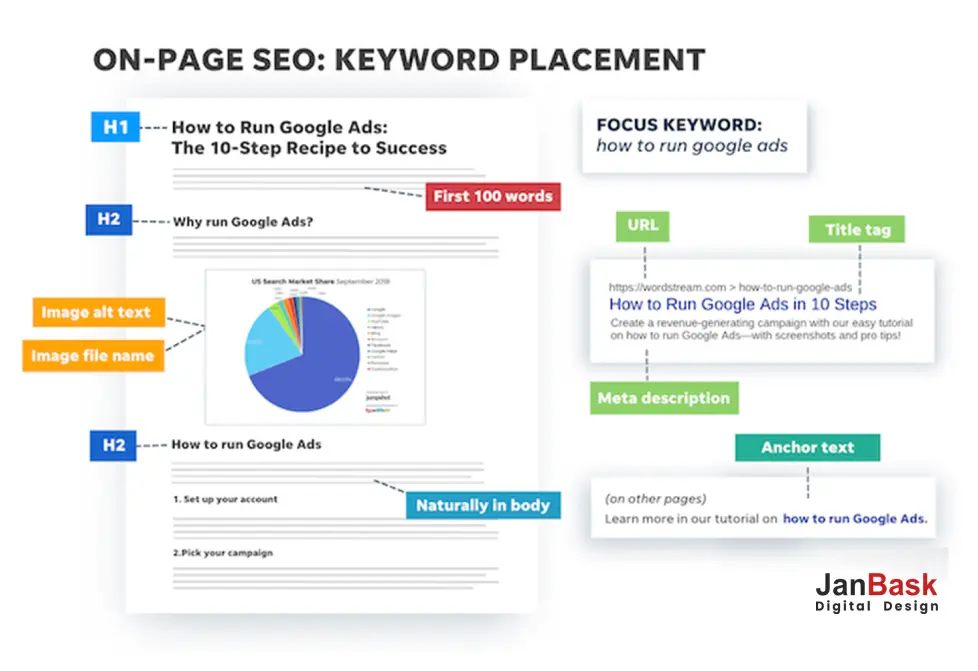
The word ‘keyword’ might sound small, but it plays a massive role as a Google ranking factor. Keywords are the prime set of words or phrases that your audience uses to find out about your products or services in the SERPs. Using these keywords within your content helps Google know better about what your website offers.
Google understands when keywords are used naturally and when they are stuffed in the content to fool the matrix. If you use too many keywords in your content that don’t add value and sound repetitive, it may be considered keyword stuffing.
Here is a list of places where you might and should consider using keywords:

Google reports that more than 50% of web traffic comes from mobile users, making it necessary for businesses to focus on their websites' mobile versions. Mobile-first indexing has been a major Google ranking factor since it was made mandatory in 2019.
Now, Google penalizes your website even if it is not mobile-friendly, irrespective of its efficiency in desktop mode. Whenever you create your website, ensure the content preview is the same for the desktop and mobile versions. Your rankings will surely suffer if the mobile version is slow, cluttered, or hard to use. A poor mobile experience can literally cost you thousands of dollars in potential business.
Some practical mobile optimization strategies to improve SEO ranking
Look at some of the most valuable sections to look into while optimizing your website for mobiles:
The website should work smoothly on all screen sizes, whether tablets or smartphones. You can use flexible grid layouts to ensure your website adjusts to screen size automatically.
Use font size for your content that is readable across all screen sizes and has sufficient contrast between text and background. Look across all screen sizes to ensure that content has generous line spacing and depicts paragraph breaks. Especially for small screens, you should avoid writing long chunks of content as it becomes overwhelming to read.
The ideal button or CTA placement across screens should be at least 44x44 pixels wide to ensure proper spacing between clickable items. Most mobiles are touch-enabled, so the icon placement should be accurate, especially on the check-out page.
Images are an essential component of your website, so they are optimized to fit across all screen sizes. You can use responsive image techniques and implement lazy loading for images to choose image formats like WebP.
Quick Loading Speed
If your website is slow, no matter how well it is optimized for desktop or mobile usage, it will suffer from high bounce rates. You should reduce your website's loading speed to less than 3 seconds. Moreover, unnecessary scripts and plugins should be minimized. Browser caching is another good way to reduce your website’s loading times while implementing AMP wherever possible.
Why is mobile optimization necessary?
Have a look at the stats below to get a better view of why mobile-first indexing is a major Google ranking factor:
Pro tips to ensure healthy diagnostics for mobile optimization:
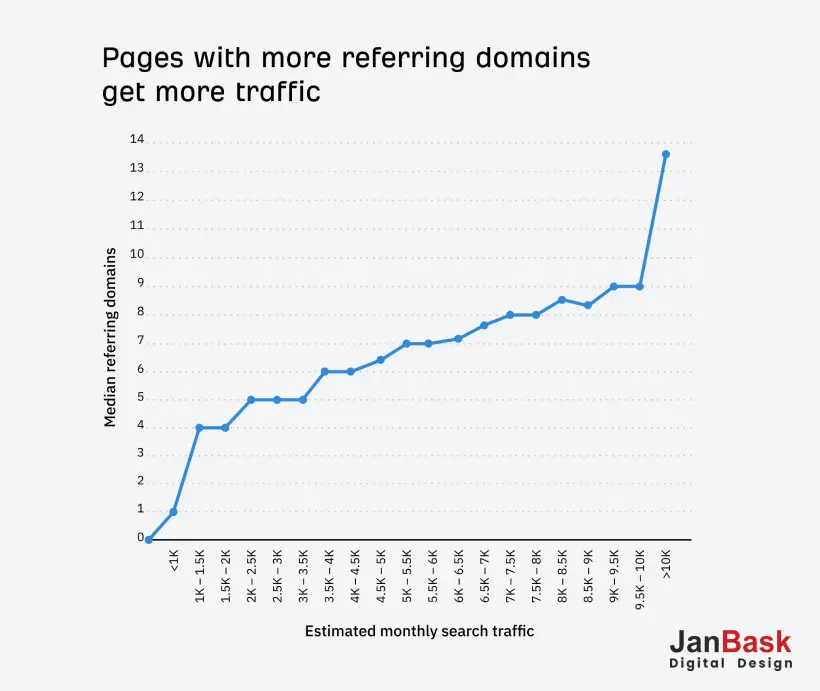
Do you know how, in the real world, a suggestion from Elon Musk beats 50 suggestions from random people on the street? In the digital world, backlinks do just that.
Think of backlinks as someone saying, "Hey, this website knows its stuff—you should check it out!" When reputable websites refer visitors to your site, Google sees it as a big thumbs-up. It’s like getting a five-star review from a famous food reviewer versus a bunch of advice reviews on a random forum.
Here’s the thing, though: in 2024, it’s not like collecting backlinks like Pokémon cards. One powerful link to a respected business website (think Forbes or a big business blog) can do more for your ranking than 20 links from those sketchy- "submit your site here" directories. Quality trumps quantity every time.
These are some effective strategies to make your backlinks a critical Google ranking factor for your website:
When it comes to building valuable backlinks, it all starts with clicking on content that people actually want to link to. Think about what makes content link-worthy – it’s all about offering unique value. One effective way is to do original research that no one else has done before. People love to quote new data and new insights. You may also want to create a comprehensive, in-depth guide that covers every aspect of the topic – we're talking about those final, definitive things that are the go-to references in your field. Don't forget to leverage your industry experience by sharing unique insights, data, tools, and products that make people’s lives easier.
Networking is another essential element, but we’re not just discussing amassing LinkedIn connections. It’s about making meaningful connections with the real influencers in your industry – the real influencers, not those whose followers have only increased. The key is to engage with them in a meaningful way, saying, "Great post!" Tell them internally while incorporating your thoughtful intentions, and focus on building real relationships before asking for anything in return.
Guest posting can be incredibly effective when done right. The secret is to be strategic without casting a wide net. Find websites where your target audience is actually spending time and offer ideas that their readers will find valuable. The goal is to create content that is so influential that they want you to contribute again. Instead of trying to appear anywhere and everywhere, focus your efforts on sites with solid industry reputations. The suitable guest posts will also give you an impressive breakthrough in SEO rankings.
Link building is also not the only strategy here—public relations is another potent approach. Many seek new information about topics they consider important within their industry. One of the best resources for providing journalists with your input is a tool called HARO, or Help A Reporter Out. Concentrate on producing important content people want to discuss and share further; do not underestimate the role of wonderful customer stories.
Last of all, don’t lock your sights and fail to see other opportunities right before you. You can go detective on your current backlinks through tools like Ahrefs or SEMrush to see who is linking to you. You would be amazed at how many broken links to your site are there – collecting such is like picking up money from the floor. Brand monitoring must involve the identification of brand mentions that have not linked back to your website, and kind contact should be made politely to request that links to the company’s sites be included. Furthermore, analysis of where competitors have been acquiring their links can be seemingly pertinent, with good opportunities unexplored.
Technical SEO might not be the most exciting aspect of digital marketing. It’s not as glamorous as creating viral content or running exciting social media campaigns. But here's the thing: your success online is being held entirely responsible by it.
We like to call it ‘the base of a house.’ You can't have a beautiful home on shaky ground, and you can't expect your digital marketing efforts to become beautiful without solid technical SEO backing them up.
As we step into 2025 and beyond, there are some technical things you need help figuring out as you go. First of all, HTTPS security is a must. Security isn’t the only one anymore; it’s about trust and ranking.
In addition to this, you will want to have a nicely set-up XML sitemap. Consider it a route to help search engines better understand and navigate your website.
Your robots.txt file may seem trivial, but it’s imperative to tell search engine crawlers how to navigate your site. It’s like a sound traffic system, guiding search engines to your desired content without wasting time.
Like potholes in a website’s road system, broken links and redirect errors must be identified and fixed as soon as possible. With canonical tags, we want to tell search engines which of many similar pages to consider the main one so they know which version to index.
Times have changed drastically regarding how Google and other search engines evaluate your website, and they’ve become much better at understanding how people interact with your site 'in the real world.' Based on these behavioral signals or user experience metrics, they're deciding how high you'll rank. It isn’t about the keywords or the backlinks anymore – it’s about how engaging and usable your site is to human visitors as a ranking factor.
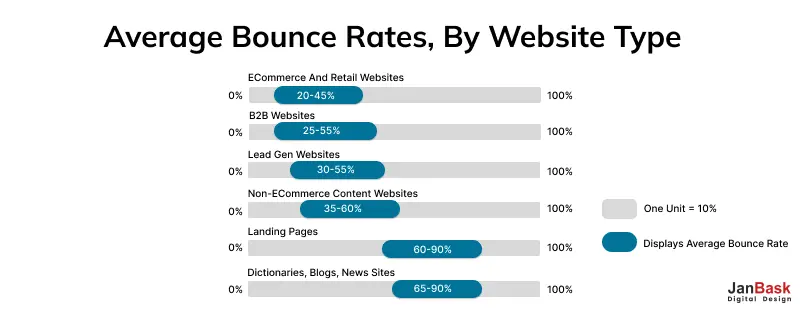
Bounce rate jumps out as an essential measuring stick when you view what key metrics you should be monitoring. In most Industries, you want to aim below 56% for a bounce rate. That means half or more of your visitors go further than just being on your landing page.
Another telling metric is the average time users spend on your pages: the longer you spend, the more likely your content is engaging. The same is true if your users go to numerous pages per session, as this strongly indicates they’re getting value from your content and wish to pursue more.
Your click-through rate from search results isn’t something you can forget about – after all, it’s your first impression of the digital world. If you have a strong click-through rate, your meta titles and descriptions describe the value to potential visitors well.

Local SEO searches have turned into an absolute lifeline for businesses with a physical location, especially as a significant Google ranking factor. Those three business listings with maps that show up in Google’s local search results are not merely decorative—they are potent drivers of real-world foot traffic. Picture being the first business that comes across when your customers are looking for services in their area.
Looking at your Google Business Profile should be the beginning of everything that you do towards local SEO. It’s not just a listing on another site – it’s your face to the world. You have to take control of this profile and make it as optimal as possible, detail for detail, to reflect your business. It’s basically similar to combining the best business card ever into a digital format, ones that potential local customers can see.
Consistent Name, Address, and Phone (NAP) information across all online platforms is considered one of the most critical aspects of local SEO. Confusing search algorithms and potential customers can diminish visibility with inconsistent information. Creating confusion and flashing light into your credibility is precisely what having different phone numbers or addresses on different business cards is like.
Without reviews, local SEO ranking is dead. Having positive reviews and responding to them professionally can help you tremendously improve your local search rankings. Every review becomes an opportunity to highlight how well you do customer service and earn trust. It shows potential customers that you’re committed to taking care of your customers, which is critical.
By creating location-specific content, you can engage with your local audience authentically. For instance, you can write about local events, tell your readers where you are involved in community projects, or tell them how your business services their needs in local markets. As you continue to get citations on related local directories, you're also building your local presence and credibility.
Optimizing for "near me" queries is increasingly essential as mobile searches rise. More and more people are using their smartphones to look for businesses in their vicinity. By optimizing your online presence for these hyperlocal searches, you put your company in the position to be the go-to business when customers are looking down the street.
Let's break it down! The top SEO ranking factors are like a secret recipe for digital success. For example, if you think of your site as a rock star trying to break into the charts, you can’t just go all good looks. Your lead guitar — high-quality, original content, your killer sound system, mobile—friendliness, stage presence, page speed, VIP backstage pass, secure HTTPS. Factors influencing SEO aren't just about technical mumbo-jumbo; they're about creating a stellar user experience that makes Google sit up and notice. Pro tip: Solve real problems for your audience, and the rankings will come naturally. It’s like creating music that people can’t help but listen to, and with Google coming of age, you’ll be in the spotlight!
Backlinks are essentially your website’s word-of-mouth recommendations. It’s pretty much the same thing — once respected food critics start being mentioned in that restaurant, it becomes hot. So, too, with your website receiving quality backlinks. The insider secret is not about gathering as many links as possible. One shout-out from a highly respected, relevant website is worth a hundred random mentions. Ultimately, google’s algorithm is innovative enough to differentiate between genuine, valuable connections and desperation search link building. Start to craft content that is unique; other respectable sites can’t help but link you naturally.
Absolutely! In the digital world, patience is rarely a virtue. It’s a deal breaker. Imagine going into a store where everything in it moves in slow motion. Frustrating, right? A slow website is exactly how users feel. That’s why page speed is a critical ranking factor, and Google knows this. Just a few seconds' delay drives potential visitors away faster than you can say bounce rate. Because mobile users are so unforgiving – they just want information lightning fast. Minify unnecessary code, optimize your images, and always use browser caching. And like a digital espresso shot, your website speed is quick, energizing, and leaves users wanting more!
Here's the truth bomb: Mobile is more important than ever — it is everything! Mobile-first indexing means to Google your mobile site is the real thing, and that's how you're being viewed. Thus if your site looks like a hot mess on a smartphone, you are basically invisible to Google. It’s like showing up to a black-tie event in beach shorts. Responsive design is not redundant – it’s your magic ticket to see them. Ensure your text is readable, buttons clickable, and your content flows effortlessly across all devices. And remember, more than half of searches today take place on mobile, which means if you’re not mobile-friendly, you’re giving money to your competition.
SEO and Social Media have a great relationship. They are more like frenemies with benefits. Although social signals are not directly ranking factors, they are the final networking tool of your digital presence. Social media is just like your website’s PR agent – getting the word out, driving traffic, and generating buzz. Backlinks and shares can increase brand visibility, and every share, like, and comment is counted as one that can generate a backlink. Waking up from viral post to viral post is not what it’s about; it’s about building meaningful connections and organically growing your online authority.
Quality is the King, but consistency is key. Don't get caught in the rut of churning out content for a box that can be ticked. A thing that Google’s algorithm is smarter than is a room full of Harvard graduates – it can smell low-quality, keyword-stuffed content from a mile away. Instead, highlight creating ultimate comprehensive, worthwhile content that actually makes your audience feel that you care, for the point of view in which we benefit from that. Your website is a living, breathing resource that changes with your industry. Fresh insights solve problems and answer user questions. Updates–regular, meaningful updates–are worth their weight in gold.
Local SEO is like having a VIP pass in your town’s local digital neighborhood! For local businesses, Google ranking factors are a unique cocktail of optimization strategies. Essentially, your digital storefront and Google My Business profile need to SHINE! Collect genuine customer reviews, have your NAP (Name, Address, Phone) consistent across all platforms, and utilize strategically location-targeted keywords. The finding isn't just about being found; it's about being found by people who want to read you when needed.
As we move forward in the digital era, it’s becoming more apparent that success in SEO requires more than just checking off a list of individual ranking factors. The most important Google ranking factors come into play while maintaining and achieving high rankings in search results. The factors that influence SEO today are more interconnected than ever before.
Think of SEO ranking as an ecosystem where each element supports and enhances the others. This ecosystem revolves around that simple principle: If you aren’t providing your users with genuine value, you don’t deserve to exist. The top Google ranking factors consistently point to one truth: To help search engines out, the content on your website is becoming less and less optimized for rankings and more and more optimized for real user needs.
Making data-driven decisions is crucial when optimizing for Google's ranking factors. Gut-feel SEO is in the past. With solid data analysis, you can build today’s successful SEO strategies based on data analysis that explains precisely how each factor affects your site’s search position. Typically, it could be analyzing the user behavior metrics tracking the conversion rates or how algorithm updates impact your rankings.
At JanBask Digital Design, we take a holistic approach to SEO and focus on the most important Google ranking factors. As a result, you'll be better positioned to achieve and maintain strong search rankings in 2024 and beyond.
Interested in our Seo Services?

Leave a Reply